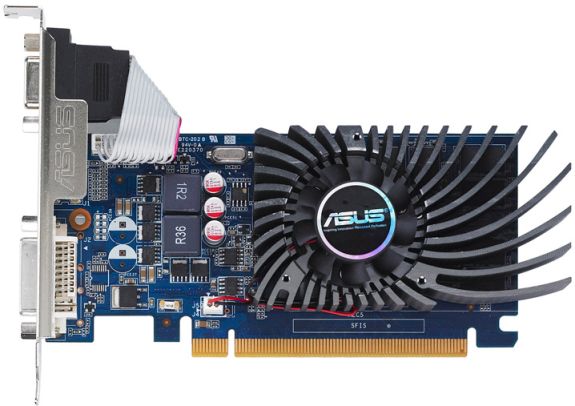
Original Link: https://www.anandtech.com/show/3973/nvidias-geforce-gt-430
NVIDIA's GeForce GT 430: The Next HTPC King?
by Ryan Smith & Ganesh T S on October 11, 2010 9:00 AM ESTIt’s been 7 months since the launch of the first Fermi cards, and at long last we’re here: we’ve reached the end of the road on the Fermi launch. Today NVIDIA is launching the final GPU in the first-generation Fermi stack into the add-in card market, launching the GeForce GT 430 and the GF108 GPU that powers it. After months of launches and quite a bit of anticipation we have the complete picture of Fermi, from the massive GTX 480 to today’s tiny GT 430.
For the GT 430, NVIDIA is taking an interesting position. AMD and NVIDIA like to talk up their cheaper cards’ capabilities in HTPC environments but this is normally in the guise of an added feature. Rarely do we see a card launched on one or two features and today is one of those launches. NVIDIA believes that they’ve made the ultimate HTPC card, and that’s the line they’re going to be using to sell it; gamers need not apply. So just what is NVIDIA up to, and do they really have the new king of the HTPC cards? Let’s find out.
| GTX 480 | GTX 460 768MB | GTS 450 | GT 430 | GT 240 (DDR3) | |
| Stream Processors | 480 | 336 | 192 | 96 | 96 |
| Texture Address / Filtering | 60/60 | 56/56 | 32/32 | 16/16 | 16/16 |
| ROPs | 48 | 24 | 16 | 4 | 8 |
| Core Clock | 700MHz | 675MHz | 783MHz | 700MHz | 550MHz |
| Shader Clock | 1401MHz | 1350MHz | 1566MHz | 1400MHz | 1340MHz |
| Memory Clock | 924MHz (3696MHz data rate) GDDR5 | 900MHz (3.6GHz data rate) GDDR5 | 902MHz (3.608GHz data rate) GDDR5 | 900MHz (1800MHz data rate) DDR3 | 790MHz (1580MHz data rate) DDR3 |
| Memory Bus Width | 384-bit | 192-bit | 128-bit | 128-bit | 128-bit |
| Frame Buffer | 1.5GB | 768MB | 1GB | 1GB | 1GB |
| FP64 | 1/8 FP32 | 1/12 FP32 | 1/12 FP32 | 1/12 FP32 | N/A |
| Transistor Count | 3B | 1.95B | 1.17B | 585M | 727M |
| Manufacturing Process | TSMC 40nm | TSMC 40nm | TSMC 40nm | TSMC 40nm | TSMC 40nm |
| Price Point | $449 | $169 | $129 | $79 | $75 |
The GT 430 is based on NVIDIA’s GF108 GPU, which like the GT21x GPUs before it, is coming to retail cards last rather than first. It’s already shipping in notebooks and prebuilt HTPCs, but this is the first time we’ve had a chance to look at just the complete card. And it really is a complete card – unlike all of NVIDIA’s other desktop launches which had GPUs with disabled functional units, the GT 430 uses a fully enabled GF108 GPU. For once with Fermi, we’ll be able to look at the complete capabilities of the GPU.
On the shader side of things, NVIDIA has taken GF106 and nearly cut it in half. We still have 1 GPC, but now it houses 2 SMs instead of 4. Each SM still contains 48 shaders, 8 texture units, and has FP64 capabilities, fulfilling NVIDIA’s commitment to FP64 capabilities (no matter how slow) on all Fermi GPUs. So yes Virginia, you can write and debug FP64 CUDA code on GF108. Attached to the shader block is 2 64bit memory controllers providing a 128bit memory bus, along with 128KB of L2 cache and a block of 4 ROPs.
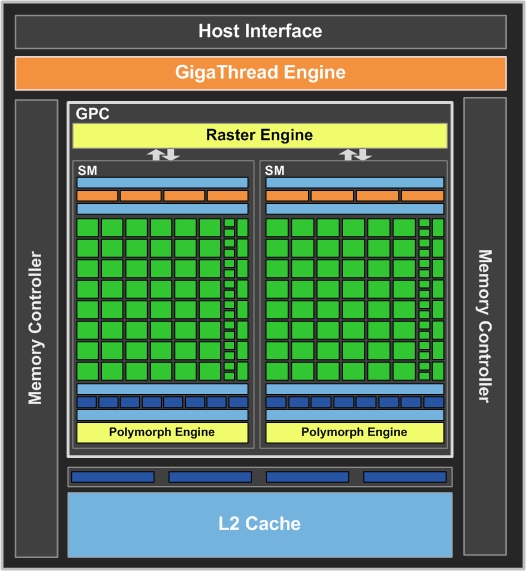
For the memory NVIDIA is using DDR3, which is still common for cards under $100 given the price premium of GDDR5. Much like the GT 240 we believe this puts the GT 430 at a memory bandwidth disadvantage, and NVIDIA is already talking about working with partners on a GDDR5 version of the card in the future. We suspect that such a card will appear once 2Gbit GDDR5 is available in sufficient volume, as NVIDIA and their partners would seem to be fixated on having 1GB of RAM for now. In practice we usually find that 512MB of GDDR5 is better than 1GB of DDR3 in most cases.
Based on what we originally saw with GF104, we had expected GF108 to be a near-perfect quarter of the GF104 die: one-quarter the shaders, one-quarter the memory controllers, one quarter the ROPs. Even though GF108 has been available for some time now in mobile, OEM, and professional parts, we’ve never really taken a look at it beyond the fact that it had 96 shaders. If we had, we would have noticed something very important much sooner: it only has 4 ROPs.
For GF100-GF106, NVIDIA paired a block of 8 ROPS with a single 64bit memory controller. At the top this gave GF100 a 384bit memory bus, and down at GF106 it had a 192bit memory bus (with the GTS 450 shipping with 2 of those 3 64bit controllers active for a 128bit bus). For GF108 NVIDIA went with 2 64bit controllers to make a 128bit memory bus, which itself is not surprising since 64bit buses have extremely limited bandwidth, and that’s only suitable for bottom-tier ultra-cheap parts of which GF108 is not. So imagine our surprise when we were looking at the final spec sheet for GF108 and noticed that it didn’t have the 16 ROPs that logic dictates would be paired with a 128bit memory bus. And imagine our further surprise when that wasn’t even 8 ROPs, which is the size of a single block of ROPs or what GT214/GT216 had.
Instead NVIDIA’s thrown us another curveball here (they keep doing that) and gone with a new ROP configuration we haven’t seen before. For GF108 there are 4 ROPs in a single block, and that block is attached to the two 64bit memory controllers that make up the GPU’s 128bit memory bus. This is a surprising change since it would have required additional work on their part to make the necessary changes to their ROPs – sticking to the standard ratio would have been much easier. In any case it’s a notable change that makes GF108 something very different than we were initially expecting.
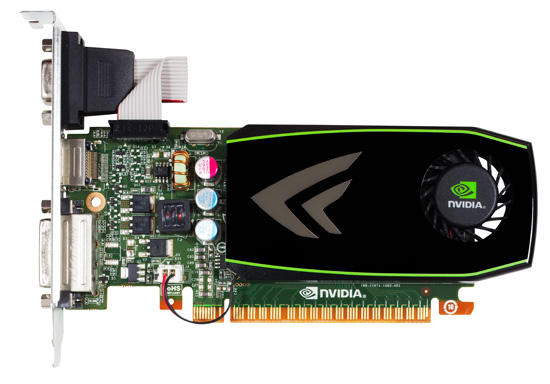
It’s the story of 4 ROPs that also sets up the positioning of the GT 430, the only retail card being released based on GF108 at the moment. With GT 430, NVIDIA has basically surrendered to AMD on performance. In a very unusual manner, you won’t find NVIDIA extoling the virtues of the card’s performance over AMD’s lineup. Even in our press briefing there was little said about gaming performance beyond the fact that it’s faster than the GT 220 and that NVIDIA believes it’s a meaningful upgrade over Intel’s IGP products due to their greater compatibility with games. Instead NVIDIA is largely selling this card upon its virtues as an HTPC card, or as NVIDIA likes to call the broader market segment: Digital Media PCs.
NVIDIA’s ace in the hole is that they have 1 thing right now that AMD doesn’t: a complete 3D stereoscopy strategy. On the hardware side this is due to the fact that GF104/106/108 all have support for HDMI 1.4a, which is necessary for full resolution 3D television/Blu-Ray and is an advantage afforded to them by the fact that AMD’s products are too old to incorporate support for HDMI 1.4a. On the other side NVIDIA has a coherent 3D strategy, with 3D Vision hardware for PC monitors, and thanks to the HDMI support for sending Blu-Ray 3D to TVs (and later this year, 3D gaming through 3D TV Play). And of course NVIDIA has bitstreaming audio capabilities for compressed lossless audio formats, bringing them up to par with AMD's audio offerings and a step up over the GT 200 series which could only support LPCM.
The long and the short of matters is that for gaming performance NVIDIA is already beat; as we’ll see even a Radeon HD 5570 DDR3 can confidently beat the GT 430, never mind the Radeon HD 5670 which can currently be found for even cheaper than the GT 430 once you factor in rebates. Even the GT 240, a card we panned hard last year is faster for the same price. With the hardware design NVIDIA has gone for, for the enthusiasts that are reading this article the GT 430 lives and dies by its HTPC capabilities; that’s NVIDIA’s position.
Moving on, since we’re looking at a low-end 40nm DirectX 11 part, this is a good time to talk about the “DX11 tax” – the fact that adding DX11 support to hardware takes up die space. We’ve already seen AMD go through this process with the 5000 series, where AMD had to spend most of their gains from the 40nm die shrink on transistors for DX11 features as opposed to transistors for overall performance. This is why cards like the Radeon HD 5450 end up being at best only as fast as the 4000 series cards they replace, and why the only major performance gains we saw when jumping generations were with GPUs that grew larger in size such as RV870. NVIDIA has to pay the same tax, and unlike AMD it’s even more obvious thanks to the fact that NVIDIA’s last-gen sub-$100 products were already 40nm.
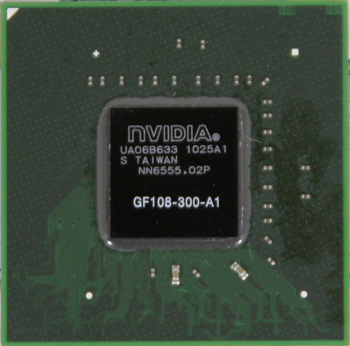
At 585 million transistors, GF108 has outright half as many transistors as GF106, and compared to the GT21x series it has 100mil more transistors than GT216 (card: GT 220) and about 150mil fewer than GT 214 (card: GT 240). Lest we forget that Fermi was a major architecture revision for NVIDIA, they still had to pay the DX11 tax – if they were to add DX11 functionality to the GT21x series, all of their products would get larger and less profitable. How they chose to pay this tax was why we’re talking about GF108 only having 4 ROPs.
On the diagrams we use to showcase GPU architectures ROPs are drawn fairly small, but in reality they’re disproportionally drawn to make it easier to fit everything else in. Modern ROPs are actually pretty big, especially 16 of them as NVIDIA’s normal ratios would call for. They aren’t a massive fraction of the GPU, but they’re big enough that they can’t hide from GPU designers looking for ways to make an economical GPU. NVIDIA needs shader cores for gaming and compute alike, they need memory controllers and cache to feed those shaders, and they need fixed function units to glue the GPU together. ROPs are necessary as arbitrators to the memory controllers and for graphics rendering, but ultimately they’re one of the few graphics-only functional units next to the texture units.
And thus NVIDIA chose to pay the DX11 tax by cutting down on ROPs. This redesign no doubt added some extra work for them, but the end result was that it allowed them to get GF108 down to the die size and power consumption of the product we see today. NVIDIA’s rational for choosing the ROPs comes down to the belief that they’re one of the least important parts of a GPU for a value product, as features such as anti-aliasing are not usually used with these products, and as we’ve seen even additional ROPs won’t make these cards playable at higher resolutions such as 1680x1050. As a result the ROPs got the axe so that NVIDIA could bring a small die GPU with DX11, low power consumption, and better than GMA/5450 performance to market.
Funny enough NVIDIA won’t give us the actual size of GF108 (they haven’t done this for any Fermi parts), but using a ruler we’d estimate the size to be 11mm x 10.5mm, or roughly 116mm2. As with transistor count this puts it between GT214 and GT216 (being closer to GT216), or roughly the same size as AMD’s Redwood GPU in the 5500/5600 families. The card’s TDP is rated at 49W, which should actually be lower than the GT216-based GT 220, even though GT216 was a smaller GPU using fewer transistors.
As for today’s launch, as is common with low-end products NVIDIA is leaving the launch in the hands of its partners. NVIDIA did produce a reference design for internal use, but it’s not being used by any shipping cards, nor were reviewers given the reference design. Instead all the cards you’ll see today, including the Asus card we’re reviewing today, are vendor custom cards.
We’ve attached a small gallery of card designs that will be shipping. There’s a complete range of cards, including full and half-height cards, and of course the obligatory passively cooled cards. There’s even a half-height passive card from Sparkle listed if you have that specific itch to scratch.
NVIDIA put the MSRP at $80, and while there aren’t any reference designs to tie this to we expect the first wave of cards to stick to this price point. At $80 the GT 430 goes directly up against the Radeon HD 5570 (DDR3 & GDDR5), sale-priced Radeon 5670s, the GT 240, and even the venerable 9800GT. All of these cards are faster in gaming performance, which is why NVIDIA’s strengths need to lie in HTPC performance and overall power consumption.
| October 2010 Video Card MSRPs | ||
| NVIDIA | Price | AMD |
| $700 | Radeon HD 5970 | |
| $500 | ||
|
|
$360 | Radeon HD 5870 |
| $300 | ||
|
|
$270 | Radeon HD 5850 |
| $230 | ||
| $220 | ||
| $170 | Radeon HD 5830 | |
| $130 | Radeon HD 5770 | |
|
GeForce GT 430
|
$80 | Radeon HD 5670/5570 |
Meet the Asus ENGT430
For our look today at the GT 430, Asus graciously provided us with their GT 430 card, the ENGT430. As with all the other cards being released it’s a custom design, featuring the usual Asus design elements: a double-sealed fan, fuse protection, and - while we have a hard time believing this is an issue on such a small card – GPU guard PCB reinforcement.
For this card Asus is very specifically going after the HTPC market. The ENGT430 is a half-height card with a low-profile bracket included, and for cooling it uses a decently sized heatsink with a particularly tiny fan we measure at 36mm. The heatsink does stick up some, so the card is explicitly a double-slot card and you’ll want to make sure you have space for it.
As is the case with low-end cards, reference clocks don’t tend to mean much. While the GT 430 has a reference speed of 700MHz for the core and 1.8GHz effective for the DDR3 memory, Asus has gone ahead and clocked the card at 1.6GHz for the memory. The card is equipped with 8 800MHz (1.6GHz effective) Hynix DDR3 memory modules running in 16bit mode, which is why the card is clocked below NVIDIA’s reference clocks. We expect to see memory clocks all over the place with the launch cards, depending particularly on who could get the best deal on what speed grade of DDR3 RAM for these cards. Given that GT 430 is likely already a memory bandwidth challenged card, this will have an impact, although we don’t have the means to measure it (our card would only go to 1.75GHz on the RAM).

For ports Asus is going with what’s undoubtedly going to be the universal configuration for low-profile GT430 cards: 1x DVI, 1x HDMI, and 1 VGA port. The DVI port is necessary for monitors (without resorting to a dongle), the HDMI port is necessary for HTPC roles, and the VGA port being an easy addition as an optional 3rd port due to its analog nature. GF108 can only drive 2 monitors at once, so the usual restrictions apply.
As is common for budget cards, there’s little else besides the card in the box. Asus includes the low-profile bracket, a multilingual quick installation guide, and a driver CD. This is the first Asus card we’ve reviewed for some time without voltage tweaking capabilities, so even NVIDIA’s integrated overclocking utility is enough for the task.
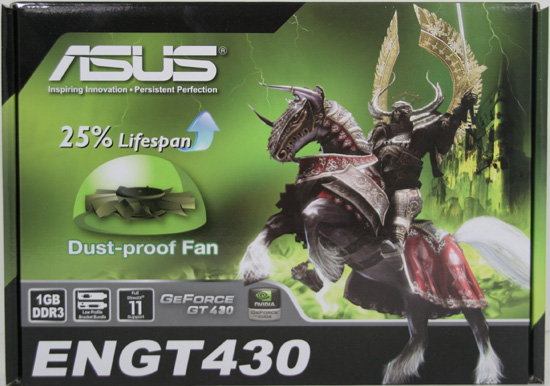
For the purpose of HTPC reviews (in particular, HQV benchmarking for discrete GPUs), we have set up a dedicated testbed with the following configuration. Considering that we will soon be having Sandy Bridge HTPCs, we have specifically tagged this as the Fall 2010 HTPC testbed.
| Fall 2010 HTPC Benchmarking Testbed Setup | |
| Processor | Intel i5-680 CPU - 3.60GHz, 4MB Cache |
| Motherboard | Asus P7H55D-M EVO |
| OS Hard Drive | Seagate Barracuda XT 2 TB |
| Secondary Drive | Kingston SSDNow 128GB |
| Memory | G.SKILL ECO Series 4GB (2 x 2GB) SDRAM DDR3 1333 (PC3 10666) F3-10666CL7D-4GBECO CAS 7-7-7-21 |
| Video Cards | Various |
| Optical Drives | ASUS 8X Blu-ray Drive Model BC-08B1ST |
| Case | Antec VERIS Fusion Remote Max |
| Power Supply | Antec TruePower New TP-550 550W |
| Operating System | Windows 7 Ultimate x64 |
| . | |
All the above components were chosen keeping extensibility in mind. The Clarkdale CPU allows us to test the Intel HD Graphics, and the PCI-E 2.0 x 16 slot can take in any HTPC oriented graphics card from ATI or nVidia. We got the fastest dual core Clarkdale processor and paired it with one of the well-reviewed LGA1156 motherboards from Asus. With USB 3.0 and eSATA support, transferring information to and from our SFF HTPCs such as the ASRock Vision 3D and Core 100 was a cinch. Keeping hard drive duties is the Seagate Barracuda XT, which strikes a fine balance between speed, power consumption and quietness. A SSD drive from Kingston was thrown in to enable us to use for some benchmarking programs we will cover in some future articles.
The G-Skill ECO series DDR3 modules fit in perfectly with the rest of the testbed. Low voltage requirements ensured that the DIMMs never heated up despite being fast and responsive. Asus was also kind enough to provide a Blu-Ray drive (internal module) which we used to play the HQV BR disc / test bitstreaming. A big chassis from Antec was chosen despite the testbed motherboard being micro-ATX. This was done in order to accommodate ATX motherboards in the future, if made necessary. The 550W Antec power supply also ensures that we can evaluate cards requiring external power connectors for HTPC purposes.
Each hardware configuration has an associated OS image which was created / restored as necessary using Clonezilla. This ensures that we do not end up with conflicting drivers while evaluating GPUs from different companies on the same base testbed. Our first evaluation using the above testbed setup was HQV benchmarking for the GT 430 and Radeon HD 5570. Read on for the results from our exercise.
GT 430 For the HTPC: HQV Benchmarking
HTPC enthusiasts are often concerned about the quality of pictures output by the system. While this is a very subjective metric, we have decided to take as much of an objective approach as possible. Starting with our HTPC reviews, we have been using the HQV 2.0 benchmark for this purpose. The HQV 2.0 test suite consists of 39 different streams divided into 4 different classes. In our HTPC(s), we use Cyberlink PowerDVD build 2113 with TrueTheater disabled and hardware acceleration enabled for playing back the HQV streams. The playback device is assigned scores for each, depending on how well it plays the stream. Each test was repeated multiple times to ensure that the correct score was assigned. The scoring details are available in the testing guide from HQV.
Given the price point and the power consumption profile of the GT 430, it is evident that it is going to compete with the Radeon HD 5570. In the table below, we indicate the maximum score possible for each test, and how much the GT 430 (with driver version 260.77) and the Radeon HD 5570 (with Catalyst 10.9) were able to get.
| GT 430 vs. HD 5570 : HQV 2.0 Benchmark | |||||
| Test Class | Chapter | Tests | Max. Score | GT 430 | HD 5570 |
| Video Conversion | Video Resolution | Dial | 5 | 4 | 5 |
| Dial with Static Pattern | 5 | 5 | 5 | ||
| Gray Bars | 5 | 5 | 5 | ||
| Violin | 5 | 3 | 3 | ||
| Film Resolution | Stadium 2:2 | 5 | 0 | 5 | |
| Stadium 3:2 | 5 | 5 | 5 | ||
| Overlay On Film | Horizontal Text Scroll | 5 | 5 | 5 | |
| Vertical Text Scroll | 5 | 5 | 5 | ||
| Cadence Response Time | Transition to 3:2 Lock | 5 | 5 | 5 | |
| Transition to 2:2 Lock | 5 | 0 | 5 | ||
| Multi-Cadence | 2:2:2:4 24 FPS DVCam Video | 5 | 0 | 5 | |
| 2:3:3:2 24 FPS DVCam Video | 5 | 0 | 5 | ||
| 3:2:3:2:2 24 FPS Vari-Speed | 5 | 0 | 5 | ||
| 5:5 12 FPS Animation | 5 | 0 | 5 | ||
| 6:4 12 FPS Animation | 5 | 0 | 5 | ||
| 8:7 8 FPS Animation | 5 | 0 | 5 | ||
| Color Upsampling Errors | Interlace Chroma Problem (ICP) | 5 | 5 | 5 | |
| Chroma Upsampling Error (CUE) | 5 | 5 | 5 | ||
| Noise and Artifact Reduction | Random Noise | SailBoat | 5 | 5 | 5 |
| Flower | 5 | 5 | 5 | ||
| Sunrise | 5 | 5 | 5 | ||
| Harbour Night | 5 | 5 | 5 | ||
| Compression Artifacts | Scrolling Text | 5 | 3 | 3 | |
| Roller Coaster | 5 | 3 | 3 | ||
| Ferris Wheel | 5 | 3 | 3 | ||
| Bridge Traffic | 5 | 3 | 3 | ||
| Upscaled Compression Artifacts | Text Pattern | 5 | 3 | 3 | |
| Roller Coaster | 5 | 3 | 3 | ||
| Ferris Wheel | 5 | 3 | 3 | ||
| Bridge Traffic | 5 | 3 | 3 | ||
| Image Scaling and Enhancements | Scaling and Filtering | Luminance Frequency Bands | 5 | 5 | 5 |
| Chrominance Frequency Bands | 5 | 5 | 5 | ||
| Vanishing Text | 5 | 5 | 5 | ||
| Resolution Enhancement | Brook, Mountain, Flower, Hair, Wood | 15 | 15 | 15 | |
| Video Conversion | Contrast Enhancement | Theme Park | 5 | 5 | 5 |
| Driftwood | 5 | 5 | 5 | ||
| Beach at Dusk | 5 | 5 | 5 | ||
| White and Black Cats | 5 | 5 | 5 | ||
| Skin Tone Correction | Skin Tones | 10 | 7 | 7 | |
| Total Score | 210 | 148 | 189 | ||
We find that the GT 430 scores the same as the GT 425M in the ASRock Vision 3D. It is also better than the Intel HD Graphics (which scored 133) with respect to this metric, but comes up short against the HD 5570.
A look at the above table reveals that there is not much to differentiate between the GT 430 and HD 5570 except for the bulk of the cadence detection tests. The all-important 3:2 pulldown is performed correctly. However, none of the other cadence detection tests passed. Getting those cadence detection features implemented in the drivers has the potential to increase the HQV score by 35 points, bringing it much closer to the 5570's score. Till then, it is hard for us to recommend the GT 430 with respect to picture quality for the average user.
Power users can always get past the cadence issues by setting up custom resolutions and refresh rates depending on the video being played back, but this not a solution for the average consumer. More concerning is the fact that many digital camcorders record at 30 fps, making it necessary to have proper cadence detection set up for 2:2 pulldown. nVidia says that this issue is being looked into, but not as a top priority feature to implement. Eventually, we should see scores similar to the 5570 a couple of driver releases down the line. For now, the Radeon HD 5570 is a clear winner from the picture quality standpoint.
The GT 430 is not as bad a HTPC card as the HQV benchmarks might lead one to believe. It is the first sub-$100 component to enable HDMI 1.4a and playback of all 3D formats. In addition, users can also expect 3DTV Play to enable them to play 3D games on a TV when NVIDIA releases that software package in the future. However, the suitability of the GT 430 for gaming purposes is covered elsewhere in this piece. From a HTPC perspective, it enables cutting-edge technology without any sort of price premium.
For a consumer interested in the 3D ecosystem, the GT 430 is definitely a better option than the similarly priced HD 5570. The GT 430 also brings the latest and greatest of VP4 to the table. This includes full MVC decode acceleration enabling hassle free playback of 3D Blu-Rays. The GPU also scored a perfect 100% in our media streamer test suite, and had no issues with bitstreaming HD audio of any kind. Flash acceleration works very well and sites such as YouTube and Hulu benefit handsomely. Silverlight also utilizes GPU acceleration. Netflix is able to take advantage of the same.
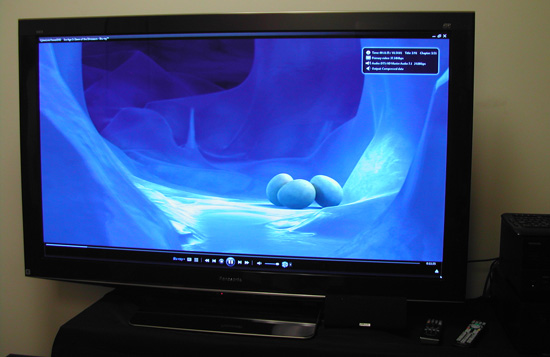
NVIDIA's 3D TV Demo Room
3D works as advertised, and I had the opportunity to simultaneously experience 3D and HD audio bitstreaming at the nVidia Santa Clara HQ demo room. More than the 3D videos, I was impressed by the stereoscopic photographs slideshow on the 3D TV enabled by the GT 430. They also had on display some 3D cameras and camcorders. With a 5 year history of developing for the 3D ecosystem, it finally looks like nVidia's efforts are beginning to bear fruit. Now, if only we could find some way to get rid of those glasses....
The Test
Although NVIDIA is not promoting the card as a competitive gaming card, we’ve gone ahead and run our full benchmark suite. For the sake of comparison with other cards we have run 1680x1050, however the GT 430 isn’t meant for that resolution. For the GT 430 and similar budget cards we have run separate results at 1280x1024 with appropriate quality settings.
For simplicity’s sake we’re only listing the DDR3 versions of the Radeon 5570 and GT 240; there’s really not much to say once we look at performance as even the DDR3 versions paint a clear picture. Conversely we’re using a DDR3 version of the GT 220 as it’s what we had on hand, although today you’re more likely to find the DDR2 version than you are the DDR3 version.
| CPU: | Intel Core i7-920 @ 3.33GHz |
| Motherboard: | Asus Rampage II Extreme |
| Chipset Drivers: | Intel 9.1.1.1015 (Intel) |
| Hard Disk: | OCZ Summit (120GB) |
| Memory: | Patriot Viper DDR3-1333 3 x 2GB (7-7-7-20) |
| Video Cards: |
AMD Radeon HD 5850 AMD Radeon HD 5770 AMD Radeon HD 5750 AMD Radeon HD 5670 AMD Radeon HD 5570 DDR3 AMD Radeon HD 4870 1GB AMD Radeon HD 4850 AMD Radeon HD 3870 NVIDIA GeForce GTX 470 NVIDIA GeForce GTX 275 NVIDIA GeForce GTX 260 Core 216 NVIDIA GeForce 8800 GT NVIDIA GeForce GTX 460 1GB NVIDIA GeForce GTX 460 768MB NVIDIA GeForce GTS 450 NVIDIA GeForce GT 240 DDR3 NVIDIA GeForce GT 220 DDR3 Asus ENGT430 |
| Video Drivers: |
NVIDIA ForceWare 197.13 NVIDIA ForceWare 257.15 Beta NVIDIA ForceWare 260.62 NVIDIA ForceWare 260.77 Beta AMD Catalyst 10.3a AMD Catalyst 10.8b |
| OS: | Windows 7 Ultimate 64-bit |
Crysis: Warhead
Kicking things off as always is Crysis: Warhead, still the toughest game in our benchmark suite. Even 2 years since the release of the original Crysis, “but can it run Crysis?” is still an important question.
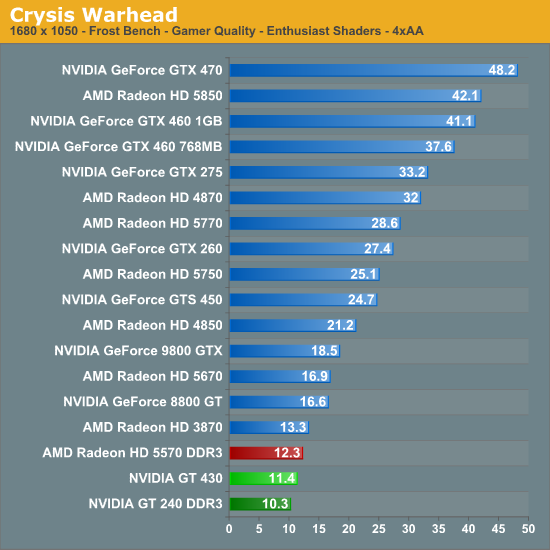
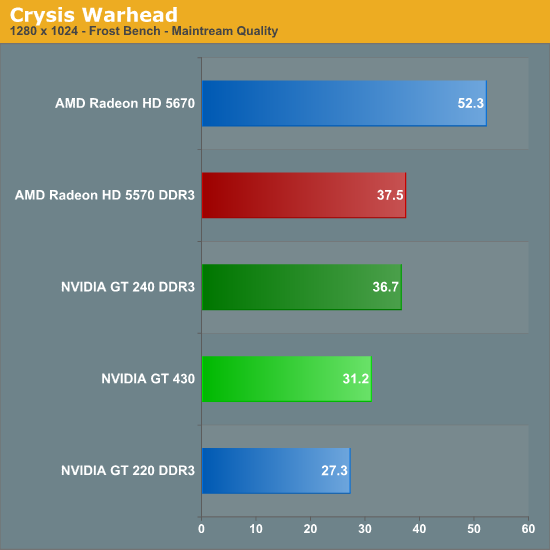
Not surprisingly, we have to turn our settings way down even at 1280 to get a playable framerate. Unfortunately the GT 430 turns up near the bottom of the pile, losing by several frames per second to the 5570, and by even more to the 5670. The GT 430 won’t lose all games by this much, but this isn’t too far off. Compared to the other cards in its price bracket it’s underpowered.
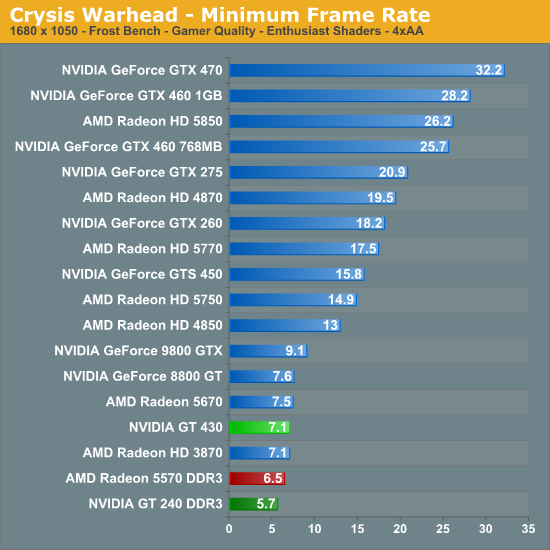
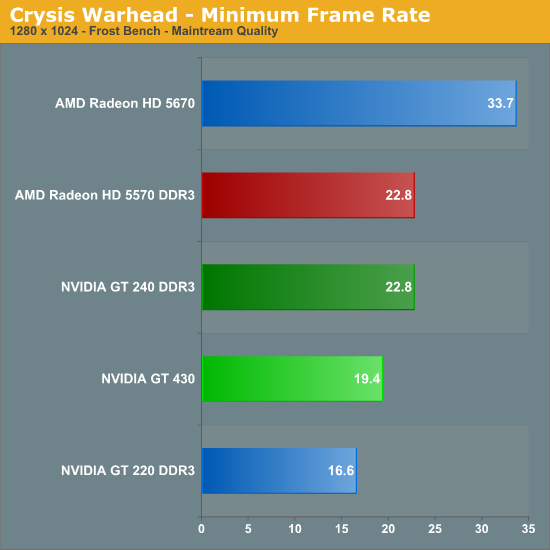
Minimums are much the same. The gap closes, but the GT 430 can only best the GT 220.
BattleForge: DX10
Up next is BattleForge, Electronic Arts’ free to play online RTS. As far as RTSes go this game can be quite demanding, and this is just at DX10. DX11 isn’t even a practical option for value cards like the GT 430.

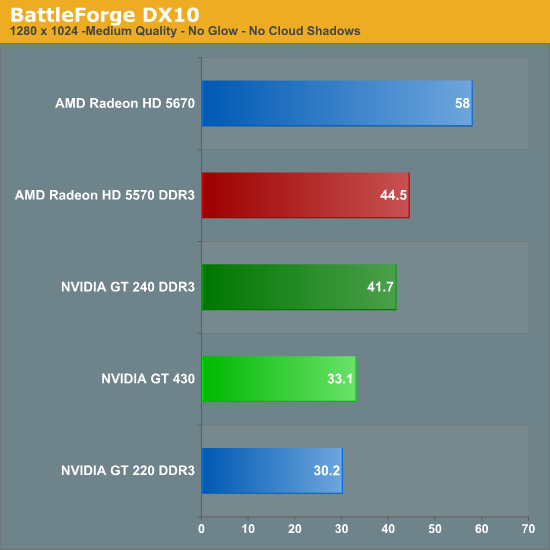
The GT 430 fares even worse here than it did in Crysis. We had always considered BattleForge to be a shader-constrained game, but at these lower settings there’s a lot of proof that we’re looking at ROPs and/or memory bandwidth, both of which the GT 430 is short on. The Radeon 5670 is approaching double the performance for the same price, a very dire outcome for the GT 430.
HAWX
Ubisoft’s aerial action game is one of the less demanding games in our benchmark suite, particularly for the latest generation of cards. However it’s fairly unique in that it’s one of the few flying games of any kind that comes with a proper benchmark.
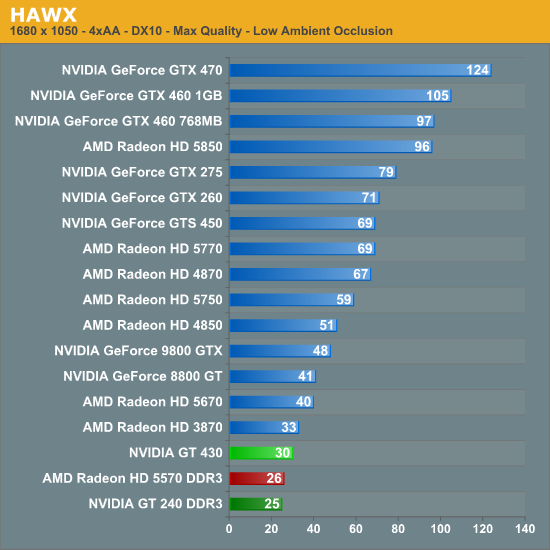

This turns out to be a significantly better game for the GT 430, and by a large margin. The GTS 450 did well here last month too, so it shouldn’t be a surprise that it’s younger sibling is equally capable. Only the 5670 reigns supreme, which means the GT 430 still underperforms for the price, but it no longer loses to the 5570 and GT 240 at least.
We’re actually not quite sure what’s going on here, other than that NVIDIA cards seem to do very well in this game.
Left 4 Dead
Introduced in 2004, Valve’s Source engine continues to live on in new Valve games. At this point even newer Source games like Left 4 Dead are rarely GPU limited to a significant degree, but we keep it on here due to the fact that we’re expecting at least one more souped-up Source game next year’s in Portal 2.
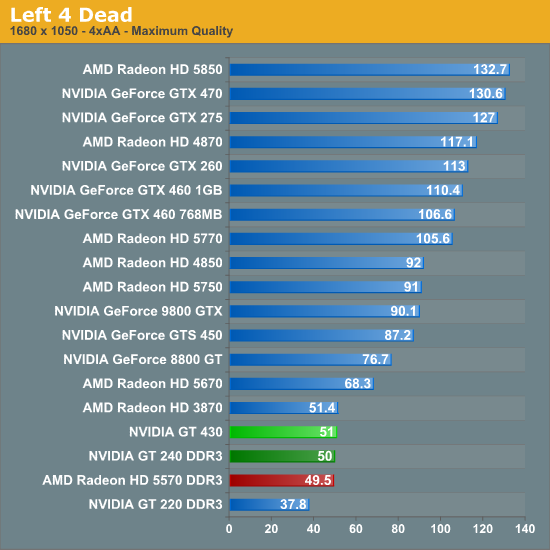
L4D is actually the one game even our value cards can deal with at 1680, showcasing the lightweight nature of the Source engine. It’s also another game the GT 430 does fairly well at, edging out the 5570 and the GT 240. Of course it’s still well behind the 5670. Interestingly this is the only game we use anti-aliasing on where the GT 430 is playable. This is solid proof of the advances made for Fermi’s ROPs, as it’s doing as well as older NVIDIA cards with twice as many ROPs.
Battlefield: Bad Company 2
The latest game in the Battlefield series - Bad Company 2 - is another one of our new DX11 games and has been a smash hit at retail. It’s also surprisingly hard on our GPUs, enough so that we can say we found something that’s more demanding than Crysis. As BC2 doesn’t have a built-in benchmark or recording mode, here we take a FRAPS run of the jeep chase in the first act, which as an on-rails portion of the game provides very consistent results and a spectacle of explosions, trees, and more.
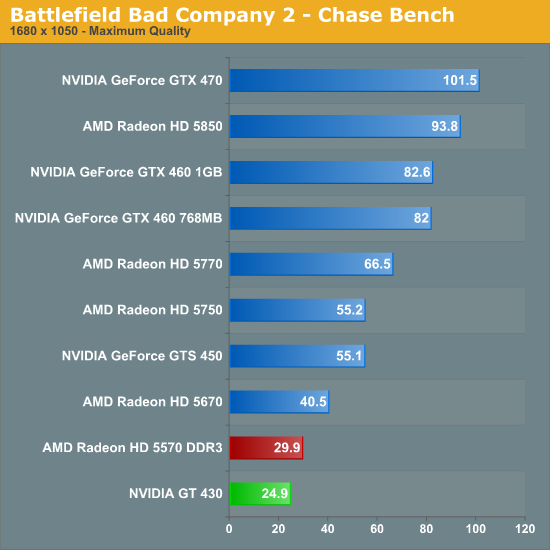
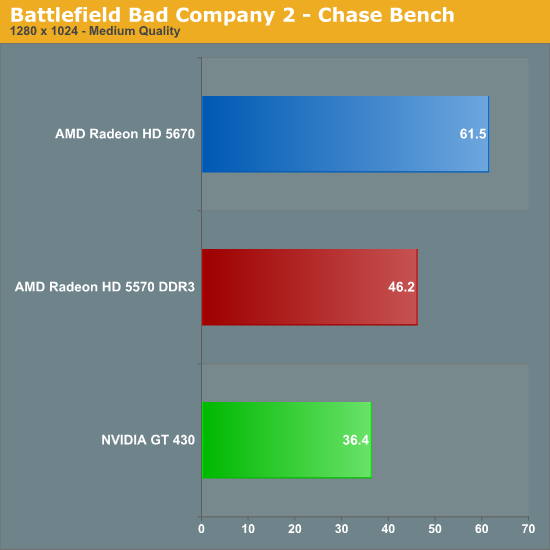
Bad Company 2 was an AMD showcase title for their DX11 cards, so it probably shouldn’t be a surprise that AMD does well here. In this case the 5570 has a 10fps lead and the 5670 extends that to 25fps, which leads to the GT 430 being playable, but the 5670 is buttery smooth here. As popular as the game is it’s hard to ignore the results; much like Crysis this is a barometer title of great importance.
STALKER: Call of Pripyat
The 3rd game in the STALKER series continues to build on GSC Game World’s X-Ray Engine by adding DX11 support, tessellation, and more. This also makes it another one of the highly demanding games in our benchmark suite.
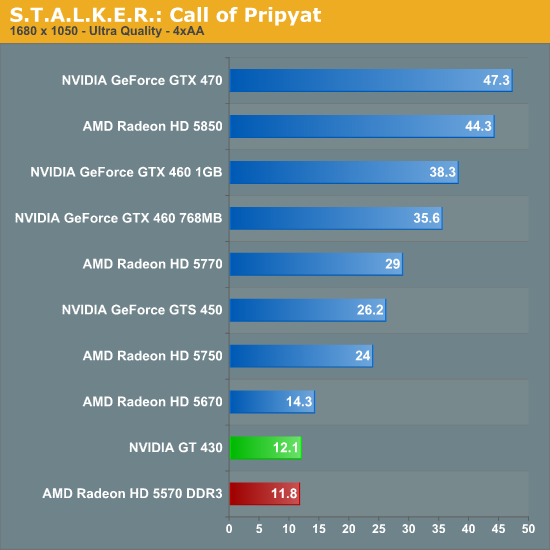

Moving on from Bad Company 2, STALKER changes NVIDIA’s fortunes some. The GT 430 still comes up last, but it’s basically neck-and-neck with the 5570. Note that even with lower settings, all of these cards struggle to be playable under DX11, and we strongly suspect this game would be better played in DX10 mode on cards of this performance level.
DIRT 2
Codemasters latest racing game marks the return of a racer to our benchmark suite. As the first DX11 racer, DIRT 2 makes pretty through use of the DX11’s tessellation abilities, not to mention being the best looking racer we have ever seen.
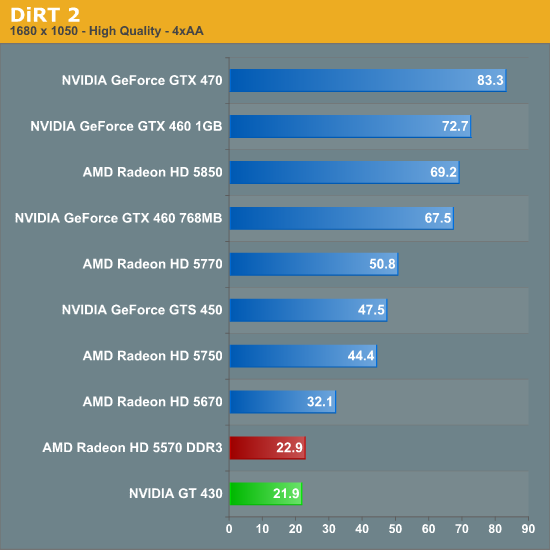
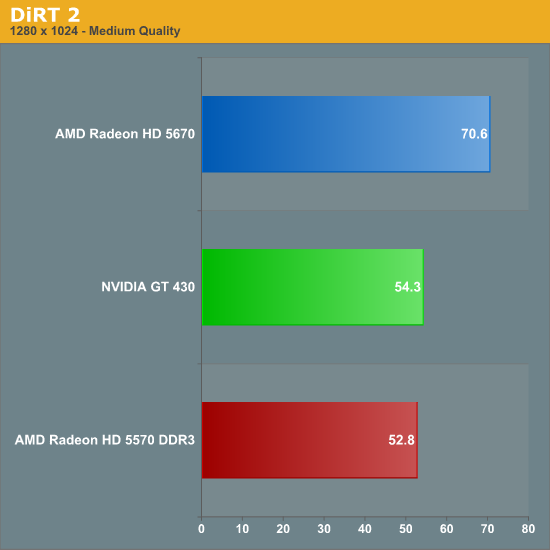
DIRT 2 finally turns the tables for NVIDIA when it comes to DX11. The GT 430 is still neck-and-neck with the 5570, but now it’s in the lead. We were actually surprised to find just how smooth this game ran at medium settings for as good as it looked at these settings. It’s not a bad tradeoff for cards at this level of performance.
Mass Effect 2
Electronic Arts’ space-faring RPG is our Unreal Engine 3 game. While it doesn’t have a built in benchmark, it does let us force anti-aliasing through driver control panels, giving us a better idea of UE3’s performance at higher quality settings. Since we can’t use a recording/benchmark in ME2, we use FRAPS to record a short run.
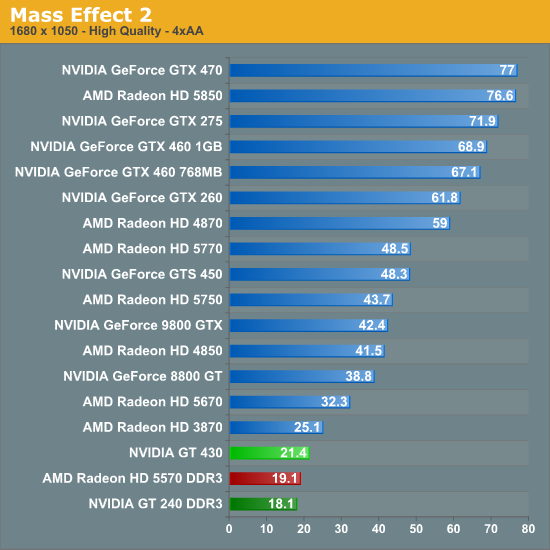
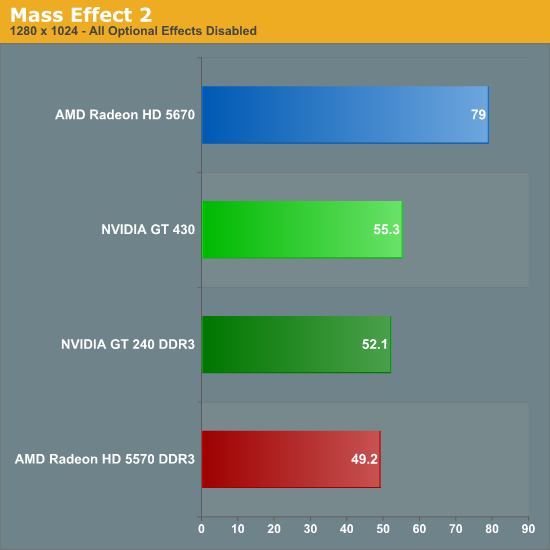
This is last and final game that NVIDIA manages to take. The GT 430 manages to take a small but comfortable lead over the 5570, nearly reaching the 60fps in the process. It doesn’t stand a chance of catching the 5670 however.
Wolfenstein
Finally among our benchmark suite we have Wolfenstein, the most recent game to be released using the id Software Tech 4 engine. All things considered it’s not a very graphically intensive game, but at this point it’s the most recent OpenGL title available. It’s more than likely the entire OpenGL landscape will be thrown upside-down once id releases Rage next year.
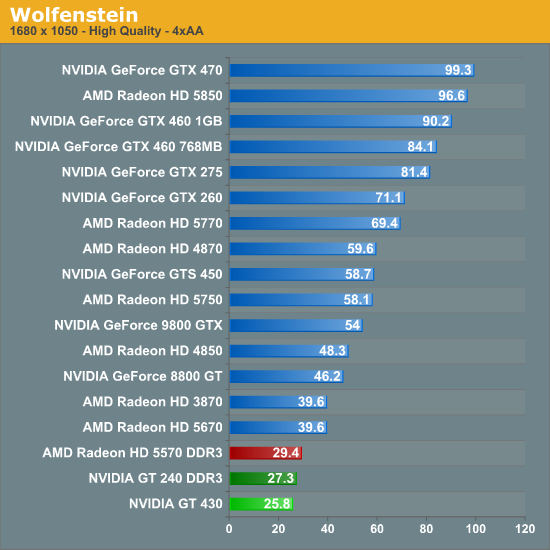
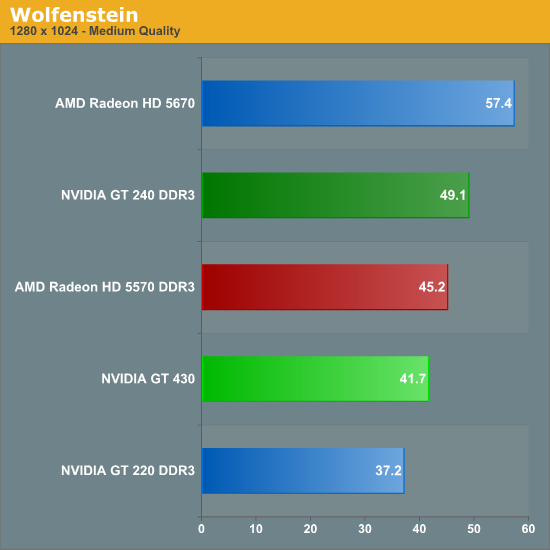
Wolfenstein always seems to be a game that AMD cards do better at, and there are no exceptions here. It’s now the 5570 that enjoys the small lead, while the GT 240 has nearly 8fps on the GT 430. It’s the last in what has become several losses for the GT 430, as we had been expecting.
Compute Performance & Synthetics
While the GT 430 isn’t meant to be a computing monster and you won’t see NVIDIA presenting it as such, it’s still a member of the Fermi family and possesses the family’s compute capabilities. This includes the Fermi cache structure, along with the 48 CUDA core SM that was introduced with GF104/GTX 460. This also means that it has a greater variation of performance than the past-generation NVIDIA cards; the need to extract ILP means the card performs between a 64 CUDA core card and a 96 CUDA core card depending on the application.
Meanwhile being based on the GF104 SM, the GT 430 is FP64 capable at 1/12th FP32 speeds (~20 GFLOPS FP64), a first for a card of this class.
For our look at compute performance we’ll turn to our trusty benchmark copy of Folding @ Home. We’ve also included the GT 240, a last-generation 96 CUDA core card just like the GT 430. This affords us an interesting opportunity to see the performance of Fermi compared to GT200 with the same number of CUDA cores in play, although GT 430 has a clockspeed advantage here that gives it a higher level of performance in theory.
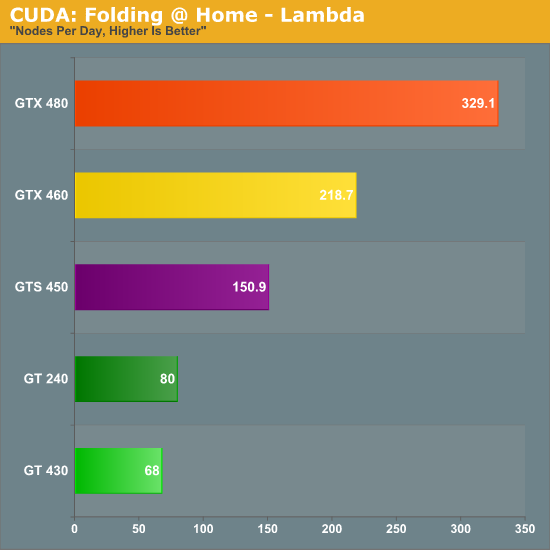
The results are interesting, but also a bit distressing. GT 430’s performance as compared to the GTS 450’s performance is quite a bit lower, but this is expected. GT 240 however manages to pull ahead by nearly 17%, which is quite likely a manifestation of Fermi’s more variable performance. This makes the GT 220 comparison all the more appropriate, as if Fermi’s CUDA cores are weaker on average then GT 430 can’t hope to keep pace with GT 240.
To take a second look at CUDA core performance, we’ve also busted 3DMark Vantage out of the vault. As we’ve mentioned before we’re not huge fans of synthetic tests like 3DMark since they encourage non-useful driver optimizations for the benchmark instead of real games, but the purely synthetic tests do serve a useful purpose when trying to get to the bottom of certain performance situations.
We’ll start with the Perlin Noise test, which is supposed to be computationally bound, similar to Folding @ Home.
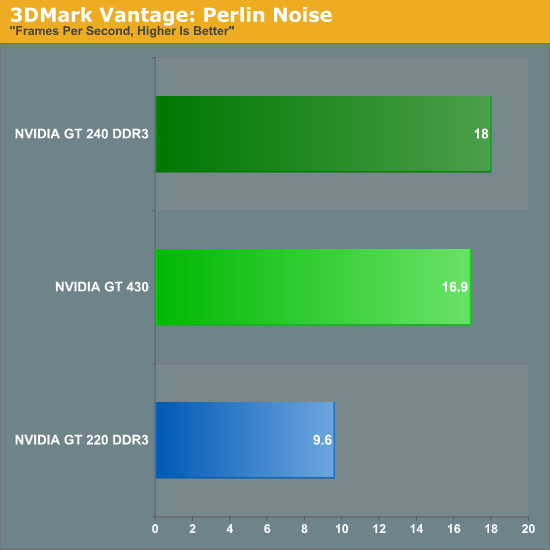
Once more we see the GT 430 come in behind the GT 240, even though the GT 430 has the theoretical advantage due to clockspeed. The loss isn’t nearly as great as it was under Folding @ Home, but this lends more credit to the theory that Fermi shaders are less efficient than GT21x CUDA cores. As a card for development GT 430 still has a number of advantages such as the aforementioned FP64 support and C++ support in CUDA, but if we were trying to use it as a workhorse card it looks like it wouldn’t be able to keep up with GT 240. Based on our gaming results earlier, this would seem to carry over to shader-bound games, too.
Moving on, we also used this opportunity to look at 3DMark Vantage’s color fill test, which is a ROP-bound test. With only 4 ROPs on the GT 430, this is the perfect synthetic test for seeing if having fewer ROPs really is an issue when we’re comparing GT 430 to older cards.
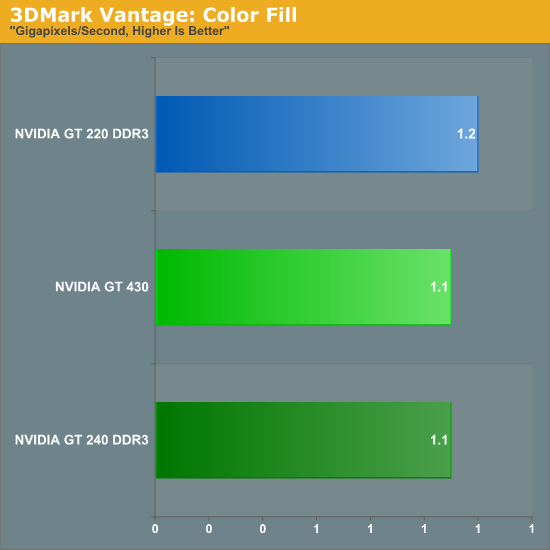
And the final verdict? A not very useful yes and no. GT 220 and GT 240 both have 8 ROPs, with GT 220 having the clockspeed advantage. This is why GT 220 ends up coming out ahead of GT 240 here by less than 100 MPixels/sec. But on the other hand, GT 430 has a clockspeed advantage of its own while possessing half the ROPs. The end result is that GT 430 is effectively tied with these previous-generation cards, which is actually quite a remarkable feat for having half the ROPs.
NVIDIA worked on making the Fermi ROPs more efficient and it has paid off by letting them use 4 ROPs to do what took 8 in the last generation. With this data in hand, NVIDIA’s position that 4 ROPs is enough is much more defensible, as they’re at least delivering last-generation ROP performance on a die not much larger than GT216 (GT 220). This doesn’t provide enough additional data to clarify whether the ROPs alone are the biggest culprit in the GT 430’s poor gaming performance, but it does mean that we can’t rule out less efficient shaders either.
Do note however that while Fermi ROPs are more efficient than GT21x ROPs, it’s only a saving grace when doing comparisons to past-generation architectures. GT 430 still only has ¼ the ROP power as GTS 450, which definitely hurts the card compared to its more expensive sibling.
Power, Temperature, & Noise
We only have 1 GT 430 card on hand, so unlike past articles we cannot compile any data on the load voltages of this line of cards. Our lone Asus card has a load voltage of 1.08v, and an idle voltage of 0.88v. Idle clocks are 50.6MHz for the core, and 270MHz effective for the memory.
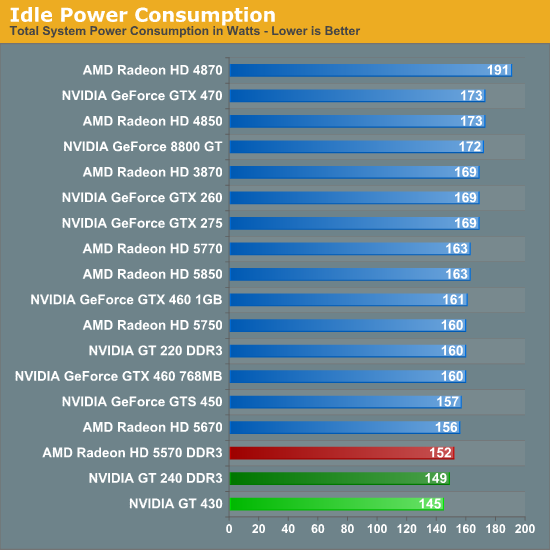
While GT 430 may not be competitive on a performance-per-dollar basis, it’s hard to argue with these power results. Even at these low wattages where our 1200W power supply isn’t very efficient, the GT 430 still delivers an idle power consumption level 7W under the Radeon 5570, and an even larger 11W advantage over the otherwise performance-superior Radeon 5670. We can’t measure the card’s actual power consumption and NVIDIA does not provide a reference level, but the GT 430 can’t be drawing more than a couple of watts here.
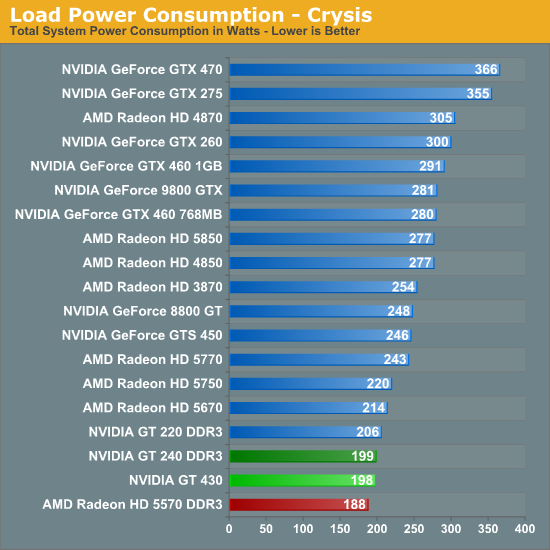
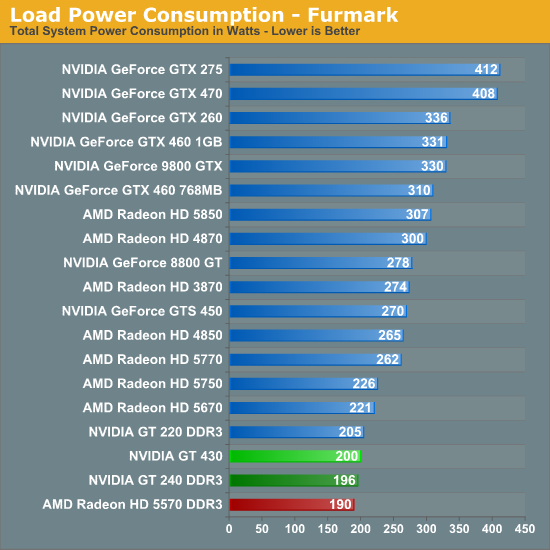
Under load things are less rosy for the GT 430. Under Crysis it ends up drawing 10W over the 5570, which serves as yet another testament to the amazing level of performance-per-watt that AMD has been able to attain; remember that the 5570 had better performance at the same time. Under Furmark the situation is just as bad, but at this point we’re looking at a more pathological case. Overall 10W isn’t going to break the bank in an HTPC (especially since these cards would rarely get up to full clocks in the first place) but it’s something to consider if every watt is going to count.
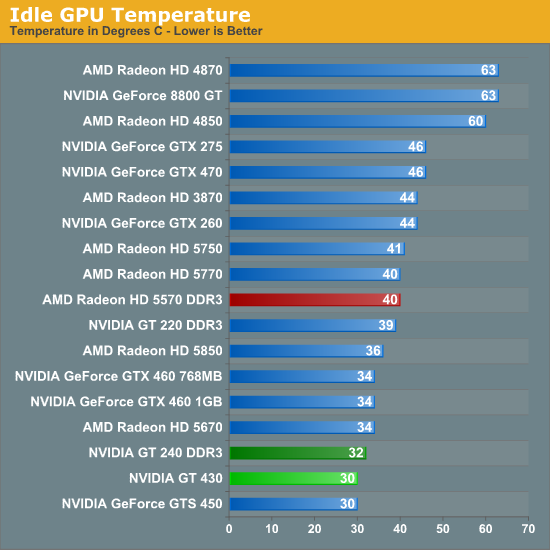
When it comes to idle temperatures, the GT 430 is second to none. With the card only consuming a couple of watts at idle in the first place, its idle temperatures are barely above room temperature (and even closer to ambient case temperatures). It’s tied with the GTS 450, which impressed us last month with its highly capable cooler. Meanwhile our 5570, which is a low-profile card just like the GT 430, ends up being a good 10C higher. AMD’s higher idle power consumption directly translates to a higher idle temperature.
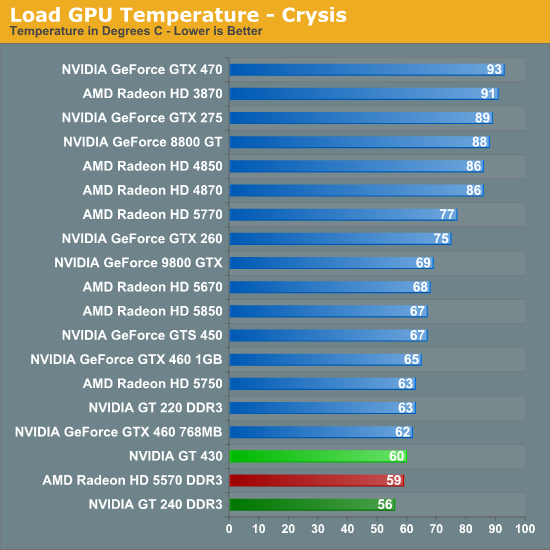
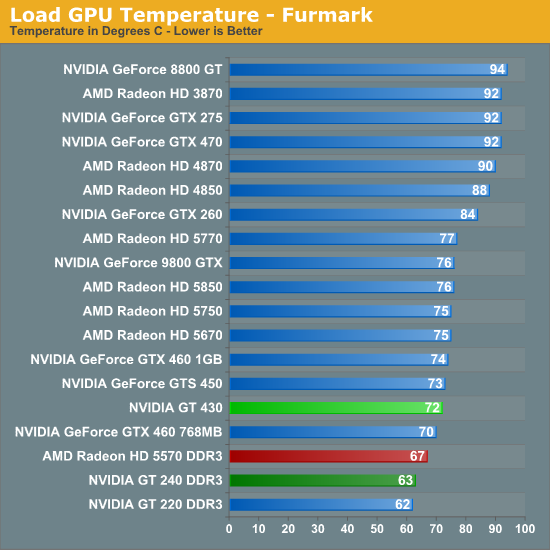
Looking at load temperatures, these results aren’t all that surprising given the cooler in use. The Asus cooler is practically a passive cooler, as the small fan is not capable of moving much air (though it is unusual to not see Asus aggressive on cooling). As a result it manages to reach higher temperatures, but we’re still only talking about 60C under Crysis and 72C under Furmark. This is worse than the 5570 and its larger fan by a bit, but not significantly so.
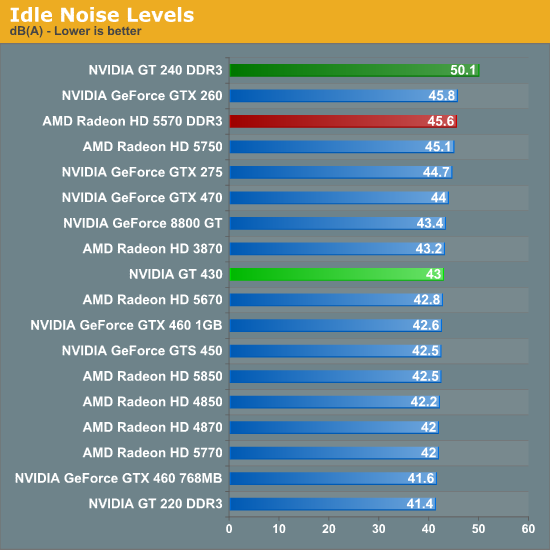
At idle the GT 430 is consistent with our other cards. With the exception of a couple ridiculous cards like our GT 240 and in this case the 5570, everything is at roughly 42-44dB(A). The 5570 is more fan than heatsink, which is likely why it has such a poor showing here compared to the GT 430.
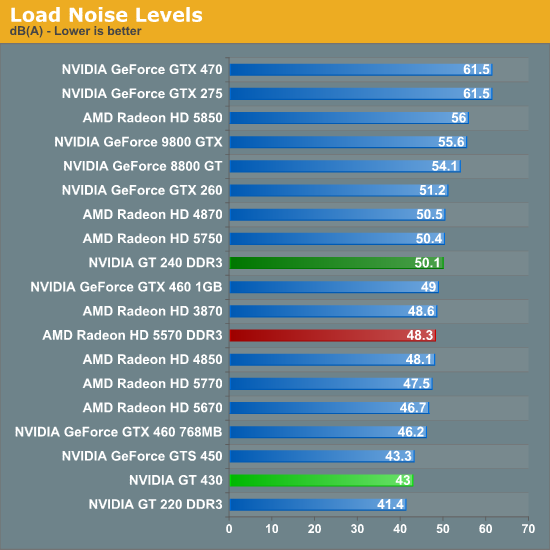
The payoff of accepting higher temperatures is less noise to contend with. The GT 430 never needs to ramp up its fan in our tests, delivering a load noise level even lower than the GTS 450, and only worse than a GT 220 that runs up against ambient noise levels. If you want to make a good HTPC card then it needs to be silent, and Asus/NVIDIA have delivered on that here. It’s not quite silent since it’s not passive, but it’s about as close as one can reasonably achieve. It’s also noticeably better than the 5570, a card which is by no means noisy. If noise is a primary concern then the GT 430 is a very good candidate for a HTPC.
Final Words
We opened up this article talking about how NVIDIA is foregoing performance in the name of digital media and HTPCs with the GT 430. Whether it’s by NVIDIA’s design or matters out of their hands, GT 430 simply isn’t competitive with AMD’s 5570 and 5670 in gaming performance, with the latter cleaning the GT 430’s clock every single time. NVIDIA isn’t pushing the GT 430 as a gaming performance card so we aren’t going to recommend it as one. If you need budget gaming, then the only choice to make is to go AMD.
With that out of the way we can get in to the meat of the issue: HTPCs. Asus is rightly pitching the ENGT430 at HTPC users, as this is the scenario most enthusiasts are even going to look at this card. So whether we can recommend the GT 430 at all is going to hinge on the GT 430’s capabilities in an HTPC environment.
Rarely are we afforded the opportunity to give a straightforward answer, and this is not one of those opportunities. NVIDIA does some things well here while stumbling in other areas. So let’s start where they stumble: image quality. In the quest for the more perfect HTPC card we found the Radeon HD 5570 earlier this year, and it was good. In more recent times AMD has put a lot of effort in to stepping up their game on image quality with the release of the HQV 2 benchmark and it shows in our results.
We always hate to rely so much on a single benchmark, but at this point HQV 2 provides the best tests we can get our hands on, so we can’t ignore the results. Certainly the GT 430 is a step up from the likes of Intel’s GMA, however the Radeon 5570 has an even bigger advantage over the GT 430. If image quality absolutely matters to you, then the Radeon 5570 is definitely the card to get for the time being until NVIDIA can spend more time on improving the video capabilities of their drivers.
So if NVIDIA stumbles on image quality, where do they excel? 3D stereoscopy. The only rational conclusion that we can draw from these results is that NVIDIA is banking hard on 3D this Christmas, like so much of the consumer electronics industry. They have HDMI 1.4a and they have 3D Vision, and as a result they’re in a position where they can offer a 3D experience that AMD cannot match. If you believe that 3D is king like NVIDIA does and you’ll be using an HTPC to experience it, then clearly there’s no other option than an NVIDIA GT 430.
NVIDIA and Asus also deserve a nod here for noise, and a weak smile for power consumption. The acoustics of the ENGT430 are fantastic, and while load power consumption runs high, idle power consumption looks good. If you’re indifferent about 3D and about picture quality, then perhaps acoustics and power consumption are worth considering? Just bear in mind that with so many vendor designs for both the AMD and NVIDIA cards, what we’re looking at today is only a small sample of what else is out there.
Finally, taking all of this in to account, we’re left with little choice but to offer a tepid reception to the GT 430. As enthusiasts, we can accept the ultimate HTPC card even if it doesn’t deliver on gaming performance, but what NVIDIA has given us is not the ultimate HTPC card. 3D and HDMI 1.4a are good, but 2nd place image quality is not. Since image quality is directly a product of driver development, there’s a great deal of hope for the future and at some point we hope we’ll be able to revisit things and to find a different conclusion.
But for the time being, NVIDIA has delivered an $80 card that is slower and offers inferior image quality compared to its competition – an unenviable position indeed. Only by 3D stereoscopy is it saved from being a flop, making the GT 430 a very significant gamble for NVIDIA. If it turns out that this isn’t a 3D Christmas then it’s not just going to be the CE companies that would be hurting.







